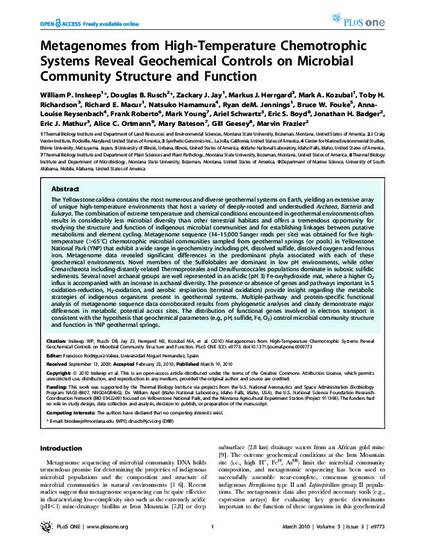
- Extreme environments - Microbiology,
- Archaebacteria,
- Hydrogen-ion Concentration,
- Oxidation,
- Photosynthetic oxygen evolution
The Yellowstone caldera contains the most numerous and diverse geothermal systems on Earth, yielding an extensive array of unique high-temperature environments that host a variety of deeply-rooted and understudied Archaea, Bacteria and Eukarya. The combination of extreme temperature and chemical conditions encountered in geothermal environments often results in considerably less microbial diversity than other terrestrial habitats and offers a tremendous opportunity for studying the structure and function of indigenous microbial communities and for establishing linkages between putative metabolisms and element cycling. Metagenome sequence (14-15,000 Sanger reads per site) was obtained for five hightemperature (>65°C) chemotrophic microbial communities sampled from geothermal springs (or pools) in Yellowstone National Park (YNP) that exhibit a wide range in geochemistry including pH, dissolved sulfide, dissolved oxygen and ferrous iron. Metagenome data revealed significant differences in the predominant phyla associated with each of these geochemical environments. Novel members of the Sulfolobales are dominant in low pH environments, while other Crenarchaeota including distantly-related Thermoproteales and Desulfurococcales populations dominate in suboxic sulfidic sediments. Several novel archaeal groups are well represented in an acidic (pH 3) Fe-oxyhydroxide mat, where a higher O2 influx is accompanied with an increase in archaeal diversity. The presence or absence of genes and pathways important in S oxidation-reduction, H2-oxidation, and aerobic respiration (terminal oxidation) provide insight regarding the metabolic strategies of indigenous organisms present in geothermal systems. Multiple-pathway and protein-specific functional analysis of metagenome sequence data corroborated results from phylogenetic analyses and clearly demonstrate major differences in metabolic potential across sites. The distribution of functional genes involved in electron transport is consistent with the hypothesis that geochemical parameters (e.g., pH, sulfide, Fe, O2) control microbial community structure and function in YNP geothermal springs.
© 2010 Inskeep et al.
This work is licensed under a Creative Commons Attribution 4.0 International License, which permits unrestricted use, distribution, and reproduction in any medium, provided the original author and source are credited.
